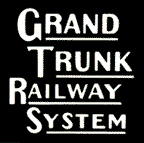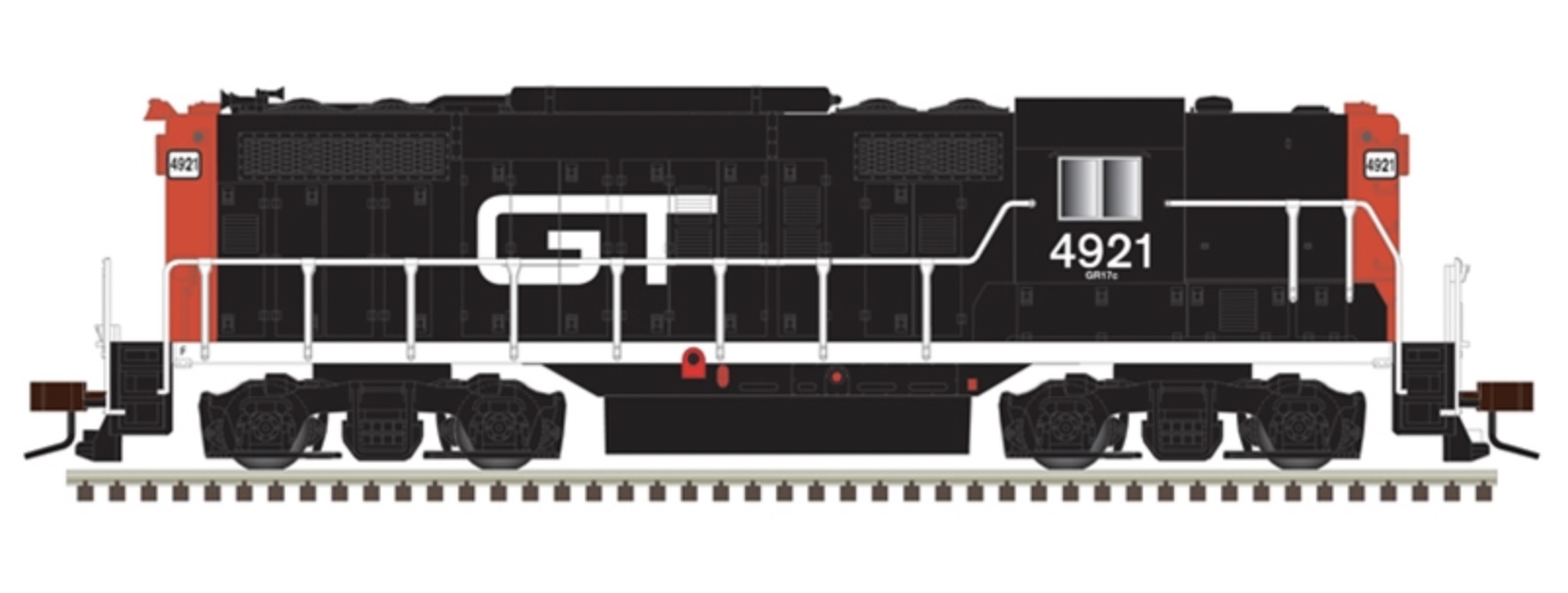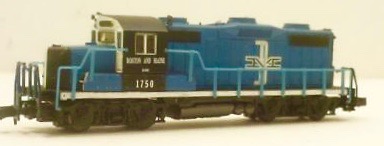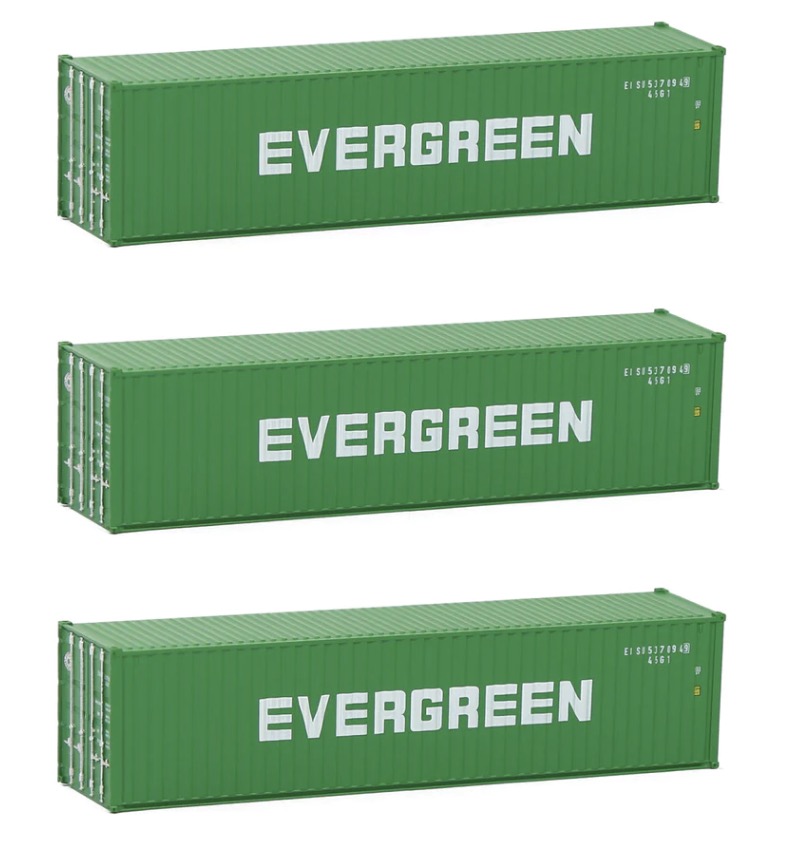Model Information: The Atlas GP7, GP7-TT, GP9 and GP9-TT models are some of Atlas' oldest models. The four locomotives share the same internal mechanisms and differ only in their shell details. Unlike many of their other older body styles, these bodies have been updated several times and are still a regular part of the Atlas production cycle.
Given their long history of releases, these models come in a plethora of different versions. The first release of this body type was in 1974 and the models were produced by Roco in Austria. Production for these models ended in 1982. The next release started in 1987 and the models were re-tooled by Kato in Japan for Atlas. The Kato version re-used the same mechanism as was used in the earlier RS3. It doesn't work as well in the Geep. The third version was made in China for Atlas and these engines were essentially a redo of the Kato mechanism (with all the faults). Finally, in 2006, the mechanism was redone properly and this 4th version is a properly DCC-Ready split frame, slow-motor modern engine.
Assembly instructions from Atlas: GP9 (Japan version), GP9 Ph.2 (China version), GP9 Torpedo Tube.
Given their long history of releases, these models come in a plethora of different versions. The first release of this body type was in 1974 and the models were produced by Roco in Austria. Production for these models ended in 1982. The next release started in 1987 and the models were re-tooled by Kato in Japan for Atlas. The Kato version re-used the same mechanism as was used in the earlier RS3. It doesn't work as well in the Geep. The third version was made in China for Atlas and these engines were essentially a redo of the Kato mechanism (with all the faults). Finally, in 2006, the mechanism was redone properly and this 4th version is a properly DCC-Ready split frame, slow-motor modern engine.
Assembly instructions from Atlas: GP9 (Japan version), GP9 Ph.2 (China version), GP9 Torpedo Tube.
DCC Information: The first version of this engine (Roco) gets a solid "No" for DCC capability, but this is no surprise as these were made in 1974. The next two releases (Kato and China) are split-frame, but also split-board. They may be DCC-Friendly, but likely it will be a fair amount of work to upgrade these. The most recent version (China, 2006+) is eminently DCC-Ready. Furthermore, most road-names and numbers produced since 2006 are available in both a DCC-Ready and a Decoder-Equipped version. Earlier DCC factory-equipped versions were fitted with Lenz LE063XF decoders, whereas most recent versions are fitted with NCE N12A2 decoders. The Atlas version of these decoders will respond to manufacturer's address "127" (CV8) i.e. "Atlas Model Railroad Products", though being identical to their original manufacturer's specification.
For non-DCC-ready versions, a wired DCC decoder installation for this model can be found on Brad Myers' N-scale DCC decoder installs blog.
Models produced since 2006 accept the following plug-in decoders:
- Digitrax DN163A4: 1.5 Amp N Scale Board Replacement Mobile Decoder for Atlas GP30 and other short Atlas diesel locomotives.
- Digitrax DN163A2: Retired decoder, replaced by DN163A4.
- NCE N12A2: Plug and play decoder for N-Scale Atlas Classic Series GP7, GP9, GP30, GP35.
- TCS ASD4 (Installation for GP7, Installation for GP9)
- MRC 1955: N-Scale Sound Decoder for Atlas GP-7, GP-9, GP-30 or GP-35
For non-DCC-ready versions, a wired DCC decoder installation for this model can be found on Brad Myers' N-scale DCC decoder installs blog.
Models produced since 2006 accept the following plug-in decoders:
- Digitrax DN163A4: 1.5 Amp N Scale Board Replacement Mobile Decoder for Atlas GP30 and other short Atlas diesel locomotives.
- Digitrax DN163A2: Retired decoder, replaced by DN163A4.
- NCE N12A2: Plug and play decoder for N-Scale Atlas Classic Series GP7, GP9, GP30, GP35.
- TCS ASD4 (Installation for GP7, Installation for GP9)
- MRC 1955: N-Scale Sound Decoder for Atlas GP-7, GP-9, GP-30 or GP-35
Prototype History: An EMD GP9 is a four-axle diesel-electric locomotive built by General Motors' Electro-Motive Division in the United States, and General Motors Diesel in Canada between January, 1954, and August, 1963. US production ended in December, 1959, while an additional thirteen units were built in Canada, including the last two in August, 1963. Power was provided by an EMD 567C sixteen-cylinder engine which generated 1,750 horsepower (1.30 MW). This locomotive type was offered both with and without control cabs; locomotives built without control cabs were called GP9B locomotives. All GP9B locomotives were built in the United States between February, 1954, and December, 1959.
One option available for locomotives without dynamic brakes, was to remove the two 22.5 in × 102 in (571.5 mm × 2,590.8 mm) air reservoir tanks from under the frame, and replace them with four 12 in × 150.25 in (304.80 mm × 3,816.35 mm) tanks that were installed on the roof of the locomotive, above the prime mover. These “torpedo tubes” as they were nicknamed, enabled the fuel and water tanks to be increased to 1,100 US gallons (4,200 l; 920 imp gal) each, although some railroads opted for roof-mounted air tanks and 2,200 US gallons (8,300 l; 1,800 imp gal) fuel tanks on their freight ‘Geeps’.
From Wikipedia
One option available for locomotives without dynamic brakes, was to remove the two 22.5 in × 102 in (571.5 mm × 2,590.8 mm) air reservoir tanks from under the frame, and replace them with four 12 in × 150.25 in (304.80 mm × 3,816.35 mm) tanks that were installed on the roof of the locomotive, above the prime mover. These “torpedo tubes” as they were nicknamed, enabled the fuel and water tanks to be increased to 1,100 US gallons (4,200 l; 920 imp gal) each, although some railroads opted for roof-mounted air tanks and 2,200 US gallons (8,300 l; 1,800 imp gal) fuel tanks on their freight ‘Geeps’.
From Wikipedia
Road Name History:  The Grand Trunk Railway (reporting mark GT) was a railway system that operated in the Canadian provinces of Quebec and Ontario and in the American states of Connecticut, Maine, Michigan, Massachusetts, New Hampshire, and Vermont. The railway was operated from headquarters in Montreal, Quebec, with corporate headquarters in London, England (Warwick House Street). It cost an estimated $160 million to build. The Grand Trunk, its subsidiaries, and the Canadian Government Railways were precursors of today's Canadian National Railways.
The Grand Trunk Railway (reporting mark GT) was a railway system that operated in the Canadian provinces of Quebec and Ontario and in the American states of Connecticut, Maine, Michigan, Massachusetts, New Hampshire, and Vermont. The railway was operated from headquarters in Montreal, Quebec, with corporate headquarters in London, England (Warwick House Street). It cost an estimated $160 million to build. The Grand Trunk, its subsidiaries, and the Canadian Government Railways were precursors of today's Canadian National Railways.
GTR's main line ran from Portland, Maine to Montreal, and then from Montreal to Sarnia, Ontario, where it joined its western subsidiary.
The GTR had three important subsidiaries during its lifetime:
Central Vermont Railway which operated in Quebec, Vermont, New Hampshire, Massachusetts, and Connecticut. Grand Trunk Pacific Railway which operated in Northwestern Ontario, Manitoba, Saskatchewan, Alberta, and British Columbia. Grand Trunk Western Railroad which operated in Michigan, Indiana, and Illinois. A fourth subsidiary was the never-completed Southern New England Railway, chartered in 1910, which would have run from a connection with the Central Vermont at Palmer, Massachusetts, to the deep-water, all-weather port of Providence, Rhode Island. A new line to Providence would have allowed for more extensive port facilities than were possible for the Central Vermont at New London, Connecticut. Construction began in 1910 and continued in fits and starts for more than 20 years until finally abandoned in the early 1930s because of the Great Depression. The loss of the SNER's strongest proponent, Grand Trunk Railway president Charles Melville Hays, on RMS Titanic in 1912 may have been the major reason that this new route to the sea was never completed. Another important factor was the unrelenting opposition of the New York, New Haven and Hartford Railroad, which fiercely protected its virtual monopoly control of rail traffic in southern New England.From Wikipedia

GTR's main line ran from Portland, Maine to Montreal, and then from Montreal to Sarnia, Ontario, where it joined its western subsidiary.
The GTR had three important subsidiaries during its lifetime:
Central Vermont Railway which operated in Quebec, Vermont, New Hampshire, Massachusetts, and Connecticut. Grand Trunk Pacific Railway which operated in Northwestern Ontario, Manitoba, Saskatchewan, Alberta, and British Columbia. Grand Trunk Western Railroad which operated in Michigan, Indiana, and Illinois. A fourth subsidiary was the never-completed Southern New England Railway, chartered in 1910, which would have run from a connection with the Central Vermont at Palmer, Massachusetts, to the deep-water, all-weather port of Providence, Rhode Island. A new line to Providence would have allowed for more extensive port facilities than were possible for the Central Vermont at New London, Connecticut. Construction began in 1910 and continued in fits and starts for more than 20 years until finally abandoned in the early 1930s because of the Great Depression. The loss of the SNER's strongest proponent, Grand Trunk Railway president Charles Melville Hays, on RMS Titanic in 1912 may have been the major reason that this new route to the sea was never completed. Another important factor was the unrelenting opposition of the New York, New Haven and Hartford Railroad, which fiercely protected its virtual monopoly control of rail traffic in southern New England.From Wikipedia
Brand/Importer Information: In 1924 Stephan Schaffan, Sr. founded the Atlas Tool Company in Newark, New Jersey. In 1933 his son, Stephan Schaffan, Jr., came to work for his father at the age of sixteen. Steve Jr. built model airplanes as a hobby and frequented a local hobby shop. Being an enterprising young man, he would often ask the owner if there was anything he could do to earn some extra spending money. Tired of listening to his requests, the hobby-store owner threw some model railroad track parts his way and said, "Here, see if you can improve on this".
In those days, railroad modelers had to assemble and build everything from scratch. Steve Jr. created a "switch kit" which sold so well, that the entire family worked on them in the basement at night, while doing business as usual in the machine shop during the day.
Subsequently, Steve Jr. engineered the stapling of rail to fiber track, along with inventing the first practical rail joiner and pre-assembled turnouts and flexible track. All of these products, and more, helped to popularize model railroading and assisted in the creation of a mass-market hobby. The budding entrepreneur quickly outgrew the limitations of a basement and small garage operation. Realizing they could actually make a living selling track and related products, Steve and his father had the first factory built in Hillside, New Jersey at 413 Florence Avenue in 1947. On September 30, 1949, the Atlas Tool Company was officially incorporated as a New Jersey company.
In 1985, Steve was honored posthumously for his inventions by the Model Railroad Industry Association and was inducted into the Model Railroad Industry Hall of Fame in Baltimore, Maryland. In addition, Steve was nominated and entered into the National Model Railroad Association Pioneers of Model Railroading in 1995.
In the early 1990s, the Atlas Tool Company changed its name to Atlas Model Railroad Company, Inc.
In those days, railroad modelers had to assemble and build everything from scratch. Steve Jr. created a "switch kit" which sold so well, that the entire family worked on them in the basement at night, while doing business as usual in the machine shop during the day.
Subsequently, Steve Jr. engineered the stapling of rail to fiber track, along with inventing the first practical rail joiner and pre-assembled turnouts and flexible track. All of these products, and more, helped to popularize model railroading and assisted in the creation of a mass-market hobby. The budding entrepreneur quickly outgrew the limitations of a basement and small garage operation. Realizing they could actually make a living selling track and related products, Steve and his father had the first factory built in Hillside, New Jersey at 413 Florence Avenue in 1947. On September 30, 1949, the Atlas Tool Company was officially incorporated as a New Jersey company.
In 1985, Steve was honored posthumously for his inventions by the Model Railroad Industry Association and was inducted into the Model Railroad Industry Hall of Fame in Baltimore, Maryland. In addition, Steve was nominated and entered into the National Model Railroad Association Pioneers of Model Railroading in 1995.
In the early 1990s, the Atlas Tool Company changed its name to Atlas Model Railroad Company, Inc.
Item created by: CNW400 on 2022-01-21 16:40:15
If you see errors or missing data in this entry, please feel free to log in and edit it. Anyone with a Gmail account can log in instantly.
If you see errors or missing data in this entry, please feel free to log in and edit it. Anyone with a Gmail account can log in instantly.









